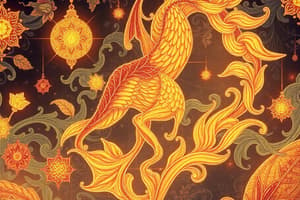Podcast
Questions and Answers
What does a negative change in energy (∆E < 0) indicate about a system?
What does a negative change in energy (∆E < 0) indicate about a system?
- The system has gained energy
- The system has lost energy (correct)
- The surrounding has lost energy
- The system is in equilibrium
The first law of thermodynamics states that energy can be created and destroyed.
The first law of thermodynamics states that energy can be created and destroyed.
False (B)
What do the symbols H for products and R for reactants represent in a chemical reaction's energy diagram?
What do the symbols H for products and R for reactants represent in a chemical reaction's energy diagram?
Enthalpy of products and enthalpy of reactants
In the equation ∆E = Q + W, Q represents _______ and W represents _______.
In the equation ∆E = Q + W, Q represents _______ and W represents _______.
Match the following energy terms with their definitions:
Match the following energy terms with their definitions:
What is the primary focus of thermochemistry?
What is the primary focus of thermochemistry?
Potential energy is energy that is actively moving.
Potential energy is energy that is actively moving.
What is the first law of thermodynamics?
What is the first law of thermodynamics?
Kinetic energy is associated with ______ while potential energy is associated with ______.
Kinetic energy is associated with ______ while potential energy is associated with ______.
Match the following terms with their definitions:
Match the following terms with their definitions:
Which of the following is NOT a type of energy discussed?
Which of the following is NOT a type of energy discussed?
Enthalpy is one of the concepts related to thermodynamics.
Enthalpy is one of the concepts related to thermodynamics.
What determines whether some chemical reactions occur while others do not?
What determines whether some chemical reactions occur while others do not?
What type of system allows for the exchange of both matter and energy with the surroundings?
What type of system allows for the exchange of both matter and energy with the surroundings?
A closed system can exchange matter with its surroundings.
A closed system can exchange matter with its surroundings.
What is the equation used to calculate the change in internal energy of a system?
What is the equation used to calculate the change in internal energy of a system?
An __________ system is one where neither matter nor energy is exchanged with the surroundings.
An __________ system is one where neither matter nor energy is exchanged with the surroundings.
Match the following system types with their characteristics:
Match the following system types with their characteristics:
What is typically focused on when dealing with internal energy changes?
What is typically focused on when dealing with internal energy changes?
Total energy for a system includes both kinetic and potential energy.
Total energy for a system includes both kinetic and potential energy.
What is meant by the sign of ∆E in energy changes?
What is meant by the sign of ∆E in energy changes?
What is the significance of Gibbs Free Energy in thermodynamics?
What is the significance of Gibbs Free Energy in thermodynamics?
Flashcards
Thermodynamics
Thermodynamics
The study of energy and its transformations in chemical and physical processes.
Chemical energy
Chemical energy
The energy stored within the chemical bonds of a substance.
Enthalpy
Enthalpy
The total energy of a system, including both its internal energy and the energy associated with its volume and pressure.
Enthalpy of reaction
Enthalpy of reaction
Signup and view all the flashcards
Calorimetry
Calorimetry
Signup and view all the flashcards
Hess’s Law
Hess’s Law
Signup and view all the flashcards
Enthalpy of formation
Enthalpy of formation
Signup and view all the flashcards
Spontaneous process
Spontaneous process
Signup and view all the flashcards
Thermochemistry
Thermochemistry
Signup and view all the flashcards
Kinetic Energy
Kinetic Energy
Signup and view all the flashcards
Potential Energy
Potential Energy
Signup and view all the flashcards
Chemical Potential Energy
Chemical Potential Energy
Signup and view all the flashcards
Internal Energy
Internal Energy
Signup and view all the flashcards
First Law of Thermodynamics
First Law of Thermodynamics
Signup and view all the flashcards
System
System
Signup and view all the flashcards
Surroundings
Surroundings
Signup and view all the flashcards
Reactants
Reactants
Signup and view all the flashcards
Products
Products
Signup and view all the flashcards
Open System
Open System
Signup and view all the flashcards
Closed System
Closed System
Signup and view all the flashcards
Isolated System
Isolated System
Signup and view all the flashcards
Internal Energy (E)
Internal Energy (E)
Signup and view all the flashcards
Energy Change (∆" )
Energy Change (∆" )
Signup and view all the flashcards
Exothermic Reaction
Exothermic Reaction
Signup and view all the flashcards
Endothermic Reaction
Endothermic Reaction
Signup and view all the flashcards
Enthalpy Change (∆" ) in Chemical Reactions
Enthalpy Change (∆" ) in Chemical Reactions
Signup and view all the flashcards
Enthalpy of Reaction (∆"rxn)
Enthalpy of Reaction (∆"rxn)
Signup and view all the flashcards
Study Notes
Lecture 4 Announcements
- Today's Topics: Brown 5.1-5.7, nature of chemical energy, first law of thermodynamics, enthalpy, enthalpy of reaction, calorimetry, Hess's law, enthalpies of formation
- Problem Set 3: Due the day before Exercise #4 and upload to Moodle
- Problem Set 4: Posted on Moodle, due before Exercise #5
- Study Center: Wednesdays 6:00 PM - 8:00 PM in ETA F5
- Office Hours: Prof. Norris and Brisby, Thursdays 5:00 PM - 6:00 PM in LEE P210
Lecture 5
- Next Week's Topics: Brown 19.1-19.6, spontaneous processes, entropy, second law of thermodynamics, molecular interpretation, third law of thermodynamics, entropy changes in chemical reactions, Gibbs free energy, free energy and temperature
Review
- Lecture 3 Review: Aqueous solutions, electrolytes, nonelectrolytes, precipitation reactions, exchange reactions, molecular reactions, complete ionic reactions, net ionic reactions, acids, bases, neutralization reactions, oxidation-reduction reactions, oxidation numbers, oxidation states, activity series, and concentration: molarity
Today: Understanding Energy
- Topic: Hydrogen combustion, work, heat, calculation
- Question: How much work, how much heat, how to calculate?
Thermodynamics I
- Today's Topic: Study of energy and its transformation; relates heat, work, and chemical reactions; laws of thermodynamics, enthalpy, and entropy
- Purpose: Explains why reactions occur or don't occur
- Today's Topic: Thermochemistry, chemical reactions produce/absorb heat
Energy
- Two Types: Kinetic energy (motion) and potential energy (stored energy)
- In Chemistry: Potential energy stored in chemical bonds
- 1st Law of Thermodynamics: Energy can be converted between different types but cannot be created or destroyed
- System: Reactants and products
- Surroundings: Everything else
System Types
- Open: Matter and energy exchanged with surroundings
- Closed: Energy exchanged with surroundings, but not matter
- Isolated: Neither matter nor energy exchanged with surroundings
Total Energy for System
- Internal Energy (E): Total kinetic plus potential energy in system
- Instead: Focus on changes in E, ΔE = Efinal - Einitial
- Usually: Occurs during a chemical reaction
Energy Changes
- Sign is Important: ΔE > 0 if system gains energy; ΔE < 0 if system loses energy
- For Chemical Reactions: Efinal is for products and Einitial is for reactants
1st Law Revisited
- As energy cannot be created or destroyed: It must go somewhere
- ΔE = q + w where q = heat added to system, w = work done on system
- Sign Convention:
- q > 0: heat added to system
- q < 0: heat removed from system
- w > 0: work done on system
- w < 0: work done by system
Heat and Work: Sign Convention
- Internal Energy: Energy deposited into system or energy withdrawn from system
- ΔE > 0 if energy deposited to system, < 0 if energy withdrawn
Endothermic and Exothermic Processes
- Endothermic: q > 0, heat absorbed by system (ex. ice melting)
- Exothermic: q < 0, heat released by system (ex. H2 combustion)
- State Functions: Internal energy, E, is an example; value depends on current state of system, not path taken to get there, also depends on quantity of matter (extensive property)
E is State Function
- ΔE: Only depends on initial and final state, not the path
- Contrast: q and w are not state functions, path matters
Enthalpy, H
- H = E + PV: Internal energy + (pressure·volume)
- E, P, and V are state functions: Thus, H is a state function
- Pressure-volume work: Work done against constant pressure
Change in Enthalpy
- ΔH = ΔE + Δ(PV): At constant pressure, ΔH = qp = heat at constant pressure
- Chemistry is typically at constant P and qp: Can determine ΔH for a reaction
- ΔH > 0: System gained heat
- ΔH < 0: System lost heat
Enthalpies of Reaction
- ΔH = Hfinal - Hinitial = Hproducts - Hreactants
- Enthalpy is extensive property: ΔHforward = -ΔHreverse
- ΔHrxn depends on state (s, l, g): of reactants and products
Calorimetry
- Used to measure ΔH: Heat flows change T
- Heat Capacity: Heat required for ΔT = 1K for particular substance
- Molar heat capacity (Cm): J/(mol·K)
- Specific heat capacity (Cs): J/(g·K)
Ex: Constant Pressure
- System (reactants) and surroundings (H2O) combined in insulated calorimeter
- If rxn is exothermic: qrxn < 0, qH₂O > 0
- If rxn is endothermic: qrxn > 0, qH₂O < 0
Ex: Constant Volume
- Can also seal vessel ("bomb")
- Then ΔErxn = qrxn = −qH₂O
Hess's Law
- If a reaction can be written in steps: ΔHrxn = sum of enthalpy changes for the steps
Other Enthalpies
- ΔHfus: Heat of fusion (melting)
- ΔHvap: Heat of vaporization (boiling)
Thermodynamics, So Far...
- We have only considered ΔE and ΔH: But this is not the whole story
- We need additional information about spontaneity and entropy: To determine if a chemical process will occur
- Next Time: 2nd Law of Thermodynamics
What We Learned
- 1st Law of Thermodynamics: System and surroundings, internal energy (E), energy diagrams, ΔE = q + w, endothermic/exothermic processes, state functions (enthalpy - H), pressure-volume work, enthalpies of reaction, calorimetry, heat capacity, Hess's law, heats of reaction, heats of formation
Studying That Suits You
Use AI to generate personalized quizzes and flashcards to suit your learning preferences.




